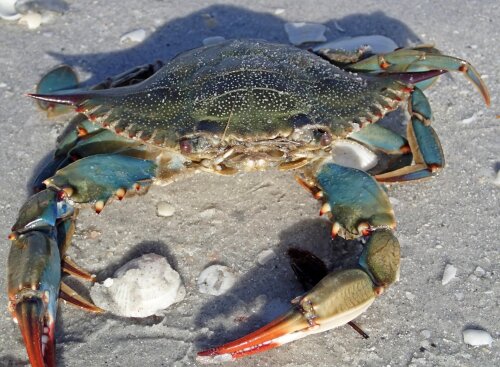Wanted dead or alive: blue crabs
The University of Antwerp is looking for Atlantic blue crabs (Callinectes sapidus). These crabs with striking blue legs and pincers occur naturally along the Atlantic coasts of North and South America, but in recent years they’ve also been spotted in Flanders. Each find will be used for research and as didactic material.

The Atlantic blue crab is yet another one that we can add to the growing list of exotic species found in Flanders. At the top of this list is the Chinese mitten crab, which is the most famous invasive crab species. The Chinese mitten crab has been on the rise in our country for a hundred years now. An invasive species is a species that settles outside its original territory and whose presence or proliferation can cause problems for the original ecosystem.
Prof. Jonas Schoelynck (Global Change Ecology Centre, Research Group Ecosphere, UAntwerp): ‘The Atlantic blue crab is a relative newcomer. It was first spotted alive in Flanders in 1993, but since then there have been only a handful of recorded sightings. In our neighbouring countries, too, only few people have seen them so far.’
Carriers of disease
But experts are worried. In Germany, the species was first observed alive in April 2023. This has led to increased vigilance and the scientists would like to stay abreast of any further sightings in Belgium.
‘We’re concerned about the increasing number of exotic crabs in our country’, Schoelynck says. ‘These animals very often compete with other organisms, disrupting food webs, transmitting diseases to other animals and disturbing the environment, causing economic and environmental damage.’
Fishermen and beachcombers
We need to learn more about this crab species so we can come up with appropriate control measures before populations get out of hand. If you find a blue crab this spring or summer, please contact the University of Antwerp by e-mail.
They’re most likely to be found along the North Sea beaches, and inland along the Scheldt all the way to Antwerp, and in the harbour docks.
Schoelynck: ‘Dead specimens are also welcome, but we’re specifically calling on professional fishermen or beachcombers to bring in live ones.’ Each specimen found will be measured and its DNA will be sequenced, and the behaviour of living specimens will be studied. The most beautiful specimen will be kept permanently as a study object for biology students.